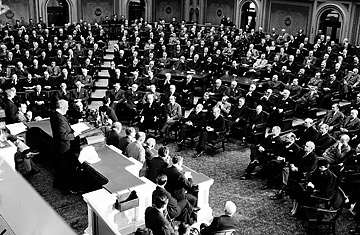
Where do you think you're going, Congress? House members, scheduled for a recess that would have released them to head back home and stump for votes, will be in Washington on Tuesday, Aug. 9, to vote on a $26 billion state-aid bill as part of a special session. That privileged-sounding title is a bit misleading, though, given that it's the equivalent of getting dismissed for summer break, only to be marched back to class for a special geometry lesson. The power to call a special session is listed among presidential responsibilities in the Constitution, though Congressional leadership has on occasion authorized them. This summer recess was supposed to be the House's second longest since 1970, but the Senate's late passage of the bill forced the lower chamber to reconvene after their work was already presumed done.
The last time the House was plucked out of summer recess was to pass an emergency spending bill in 2005, following Hurricane Katrina. And earlier that year, Republican leaders had called members back on Palm Sunday to deal with the case of Terri Schiavo, whose husband wanted to remove her feeding tube following Schiavo's 15 years in a vegetative state. (Republican leaders opposed the measure alongside Schiavo's parents, though they were eventually overruled by the courts.) But, according to the House historian's office, House members have only returned during summer breaks to do business two other times — once in 1980 and once in 1991 — in the past 30 years.
Before the passage of the 20th Amendment in 1933, which changed Congress' schedule and eliminated much of the need to interrupt breaks, the President had called just the Senate into special sessions on 46 occasions to ratify treaties, confirm Cabinet nominations and the like. On 27 other occasions, both chambers were called in, usually to deal with bigger crises such as war and economic turmoil. Perhaps the most famous special session dealt with the former. On Independence Day in 1861, four months after Congress had adjourned in the traditional pre-1933 month of March, Abraham Lincoln summoned legislators to deal with the outbreak of the Civil War. As the 44 assembled Senators gathered (21 were absent), Lincoln set a special tone: "Having been convened on an extraordinary occasion, as authorized by the Constitution, your attention is not called to any ordinary subject of legislation." Those present then proceeded to swear in two compatriots from the newly admitted state of Kansas. During the following 34 days, legislators passed 67 major public laws.
Much of the special-session action following the 1933 passage of the 20th Amendment took place under Franklin D. Roosevelt, who first brought Congress out of recess during the Great Depression to pass emergency banking and relief measures; that special session eventually became known as the "first hundred days" of the New Deal. He then summoned Congress in 1937 to enact legislation establishing work minimum wages and maximum hours and called it back in 1939 following the German invasion of Poland. President Harry Truman also used multiple special sessions, reconvening legislators in 1947 and 1948 in the name of unfinished domestic business.
Just because official special sessions have become increasingly rare, however, that doesn't mean legislators have been free to flit about Martha's Vineyard in their summers. In fact, the August recess was only formalized in 1970 following three grueling years under Lyndon Johnson, during which Congress was in session an average of 323 days. Legislators also worked continuously — a full 366 days in the 1940 session — during World War II. This summer, House members will still get about 32 days off. And though this meeting might lack the drama of Lincoln's and Roosevelt's, it will have one quality theirs did not. On Aug. 4, Nancy Pelosi became the first House Speaker to announce a special session via Twitter (and House minority leader John Boehner quickly tweeted by way of retort). So no matter what happens, it's still worth a historical footnote, if only a 140-character one.
